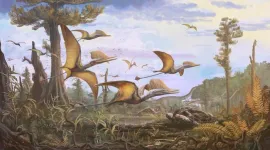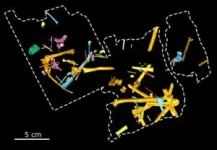(Press-News.org) A new species of pterosaur from specimens found on the Isle of Skye, Scotland, has been announced by scientists from the Natural History Museum, University of Bristol, University of Leicester, and University of Liverpool.
The new pterosaur is part of the Darwinoptera clade of pterosaurs. Its discovery shows that the clade was considerably more diverse than previously thought, and persisted for more than 25 million years, from the late Early Jurassic to the latest Jurassic. During this period species within the clade spread worldwide.
The discovery underpins a new and more complex model for the early evolution of pterosaurs.
The rarity of Middle Jurassic pterosaur fossils and their incompleteness has previously hampered attempts to understand early pterosaur evolution. This discovery shows that all principal Jurassic pterosaur clades evolved well before the end of the Early Jurassic, earlier than previously realised. The discovery also shows that pterosaurs persisted into the latest Jurassic, alongside avialans, the dinosaurs which eventually evolved into modern birds.
The remains consist of a partial skeleton of a single individual, including parts of the shoulders, wings, legs and backbone. Many of the bones remain completely embedded in rock and can only be studied using CT-scanning.
Professor Paul Barrett, Merit Researcher at the Natural History Museum and senior author on the paper, said: “Ceoptera helps to narrow down the timing of several major events in the evolution of flying reptiles. Its appearance in the Middle Jurassic of the UK was a complete surprise, as most of its close relatives are from China. It shows that the advanced group of flying reptiles to which it belongs appeared earlier than we thought and quickly gained an almost worldwide distribution.”
Prof. Barrett and his colleagues described the new species, naming it Ceoptera evansae: Ceoptera from the Scottish gaelic word Cheò, meaning mist (a reference to the common gaelic name for the Isle of Skye Eilean a’ Cheò, or Isle of Mist), and the Latin -ptera, meaning wing. Evansae honours Professor Susan E. Evans, for her years of anatomical and palaeontological research, in particular on the Isle of Skye.
Lead author Dr Liz Martin-Silverstone, a palaeobiologist from the University of Bristol, said: "The time period that Ceoptera is from is one of the most important periods of pterosaur evolution, and is also one in which we have some of the fewest specimens, indicating its significance. To find that there were more bones embedded within the rock, some of which were integral in identifying what kind of pterosaur Ceoptera is, made this an even better find than initially thought. It brings us one step closer to understanding where and when the more advanced pterosaurs evolved."
The study A new pterosaur from the Middle Jurassic of Skye, Scotland and the early diversification of flying reptiles is published in the Journal of Vertebrate Paleontology. It can be accessed here after publication.
Press contact
Natural History Museum Press Office
Tel: +44 (0)20 7942 5654 / 07799690151
Email: press@nhm.ac.uk
END
New species of Jurassic pterosaur discovered on the Isle of Skye
2024-02-06
ELSE PRESS RELEASES FROM THIS DATE:
Influence of voting advice web tools is limited during elections with authoritarian candidates, study shows
2024-02-06
The influence of online vote advice tools designed to help voters discover more about candidates is limited when elections are affected by authoritarianism, a new study shows.
Voting advice applications offer voters nonpartisan information about political parties, candidates, and policy issues.
The research shows they could be an alternative source of information for those interested in learning about politics in democracies, but their use would be limited in authoritarian settings, particularly in the longer term.
In the short-term, and during highly competitive elections with tiny winning margins for candidates ...
Solving an age-old mystery about crystal formation
2024-02-06
A million years ago, the oldest known species to walk upright like a human, the Homo Erectus, had a human-like fascination with crystals. Historians can even pin down the possible reasons – crystals didn’t look like anything around at the time - trees, valleys, mountains. Crystals were a material to ponder, a fascinating diversion for the mind.
To this day, the human preoccupation with the magic of crystals continues to fill the mind’s eye of scientists who have developed ways to use crystals for everything from malaria cures to solar cells and semiconductors, catalysts and optical elements. Over the years crystals have become crucial constituents ...
New research shows AI dog personality algorithm could match you with your new ‘best friend’
2024-02-06
A multi-disciplinary research team specializing in canine behavior and Artificial Intelligence has developed an AI algorithm that automates the high-stakes process of evaluating potential working dogs’ personalities. They hope to help dog training agencies more quickly and accurately assess which animals are likely to succeed long term in careers such as aiding law enforcement and assisting persons with disabilities. The personality test could also be used for dog-human matchmaking, helping shelters with proper placement, thus reducing the number of animals returned ...
In a warming world, climate scientists consider category 6 hurricanes
2024-02-05
– By Linda Vu
For more than 50 years, the National Hurricane Center has used the Saffir-Simpson Windscale to communicate the risk of property damage; it labels a hurricane on a scale from Category 1 (wind speeds between 74 - 95 mph) to Category 5 (wind speeds of 158 mph or greater).
But as increasing ocean temperatures contribute to ever more intense and destructive hurricanes, climate scientists Michael Wehner of Lawrence Berkeley National Laboratory (Berkeley Lab) and James Kossin of the First Street Foundation wondered whether the ...
Better together: Beckman imaging facilities share $3 million Alzheimer’s research grant
2024-02-05
What do a synthetic chemist, a medical imaging expert, and a neurologist have in common? They’re coming together in the Biomedical Imaging Center at the Beckman Institute for Advanced Science and Technology to develop better diagnostic tools and imaging agents to detect early-stage Alzheimer’s disease and other neurodegenerative diseases.
The dream team
A team led by Liviu M. Mirica along with Wawryzneic “Wawosz” Dobrucki and Dr. Daniel A. Llano received a $3 million grant from the U.S. National Institute on ...
$1.9 million NIH grant to support research on impacts of the microbiome on human health
2024-02-05
UNIVERSITY PARK, Pa. — The bacteria and microorganisms that live within the human body — the microbiota — can impact human health, disease risk and even how the body absorbs medications, but the details of these processes are unclear. To help understand how complex communities of microbes impact human health, the National Institutes of Health’s National Institute of General Medical Science has awarded a 5-year, $1.9 million Maximizing Investigator’s Research Award to Jordan Bisanz, assistant professor of biochemistry and molecular biology in the Penn State Eberly College of Science.
“It is clear that the diversity of microbes in the ...
First representative survey of energy insecurity in New York City
2024-02-05
Researchers at Columbia University Mailman School of Public Health and the New York City Department of Health and Mental Hygiene conducted the first representative survey of energy insecurity and health of New York City residents.
The study’s findings – including that energy insecurity is experienced by approximately 30 percent of New York City (NYC) residents – are published online and in print, in the February issue of the journal Health Affairs. The study and its results help officials understand challenges faced by residents and develop possible interventions and efforts in response.
Results ...
Primary care housing intervention linked to improved patient health outcomes
2024-02-05
Brigham researchers found that participation in a housing program was associated with fewer outpatient visits, improved physical and mental health, and stronger connections to their primary care clinics and care team.
Lack of safe and affordable housing is a critical issue in the United States and creates immense challenges for patients’ health, well-being, and ability to access care. Investigators from Brigham and Women’s Hospital, a founding member of the Mass General Brigham healthcare system, evaluated data from a social ...
MSU researchers find early, promising glioblastoma treatment
2024-02-05
MSU has a satellite uplink/LTN TV studio and Comrex line for radio interviews upon request.
EAST LANSING, Mich. – A team of Michigan State University scientists has unveiled a potential game-changer in the fight against glioblastoma, the most common and currently incurable form of brain cancer.
A team of Michigan State University scientists has unveiled a potential game-changer in the fight against glioblastoma, the most common and currently incurable form of brain cancer.
Their weapon of choice? ...
Are body temperature and depression linked? Science says, yes
2024-02-05
People with depression have higher body temperatures, suggesting there could be a mental health benefit to lowering the temperatures of those with the disorder, a new UC San Francisco-led study found.
The study, publishing today in Scientific Reports, doesn’t indicate whether depression raises body temperature or a higher temperature causes depression. It’s also unknown whether the higher body temperature observed in people with depression reflects decreased ability to self-cool, increased generation of heat from metabolic processes or a combination of both.
Researchers analyzed data from more than 20,000 international ...






